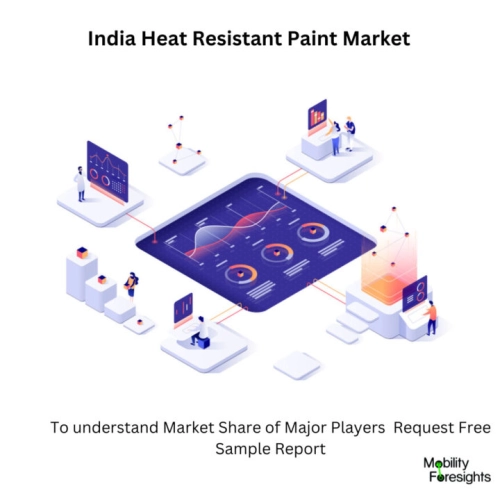
- Get in Touch with Us

Last Updated: Apr 25, 2025 | Study Period: 2023-2030
Heat resistant paints and coatings are created to protect surfaces from fast temperature fluctuations and extreme heat. High temperature paint can withstand temperatures of up to 600 °C.
The surfaces of boilers, pipelines, furnaces, incinerators, and chimneys are frequently painted with heat-resistant paint in chemical plants, paper mills, and refineries.
These paints can be applied on steam pipes, chimneys, fans, ovens, stoves, fireplaces, grills, kilns, and boilers at home.It prevents rust and corrosion from forming on the surface underneath the paint. resists breaking down at high temperatures. can endure temperatures between 400 and 1200 degrees Celsius.

The India Heat Resistant Paint market accounted for $XX Billion in 2022 and is anticipated to reach $XX Billion by 2030, registering a CAGR of XX% from 2023 to 2030.
Indicus Paints Launches New âHeatsealâ Heat Reflective Coating that Makes Buildings Cooler and Energy Efficient.Indicus is the first company in India to release a device that is solely intended to deflect heat.
The new Indicus Heatseal increase is the next generation coating with increased waterproofing capabilities, replacing the Indicus Heatseal that was introduced a year ago.
The covering immediately deflects solar energy back into the environment, cooling the structure by up to 10C. As a result, the comfort of the residents during hot weather is considerably improved, and electricity consumption from running fans and air conditioners is decreased.
A humorous TV commercial highlighting heat reflection was also released in conjunction with the introduction of Indicus Heatseal Advanced. The TVC attempts to familiarise a larger audience with this technology and demonstrate the heat reflecting coating technology in an approachable and lighthearted way.Microspheres, which are small thermoplastic bubbles filled with gas, are a distinctive addition to Heatseal.
In addition to making the coating elastic, they create gaps in the coatings that lessen thermal transmission into the building. This prevents water from leaking through the fractures by allowing the coating to expand and contract with the structure. It is a coating option that offers advantages in all seasons since the product may offer great protection from both the scorching sun and monsoon rains.
| Sl no | Topic |
| 1 | Market Segmentation |
| 2 | Scope of the report |
| 3 | Abbreviations |
| 4 | Research Methodology |
| 5 | Executive Summary |
| 6 | Introduction |
| 7 | Insights from Industry stakeholders |
| 8 | Cost breakdown of Product by sub-components and average profit margin |
| 9 | Disruptive innovation in the Industry |
| 10 | Technology trends in the Industry |
| 11 | Consumer trends in the industry |
| 12 | Recent Production Milestones |
| 13 | Component Manufacturing in US, EU and China |
| 14 | COVID-19 impact on overall market |
| 15 | COVID-19 impact on Production of components |
| 16 | COVID-19 impact on Point of sale |
| 17 | Market Segmentation, Dynamics and Forecast by Geography, 2022-2030 |
| 18 | Market Segmentation, Dynamics and Forecast by Product Type, 2022-2030 |
| 19 | Market Segmentation, Dynamics and Forecast by Application, 2022-2030 |
| 20 | Market Segmentation, Dynamics and Forecast by End use, 2022-2030 |
| 21 | Product installation rate by OEM, 2022 |
| 22 | Incline/Decline in Average B-2-B selling price in past 5 years |
| 23 | Competition from substitute products |
| 24 | Gross margin and average profitability of suppliers |
| 25 | New product development in past 12 months |
| 26 | M&A in past 12 months |
| 27 | Growth strategy of leading players |
| 28 | Market share of vendors, 2022 |
| 29 | Company Profiles |
| 30 | Unmet needs and opportunity for new suppliers |
| 31 | Conclusion |
| 32 | Appendix |